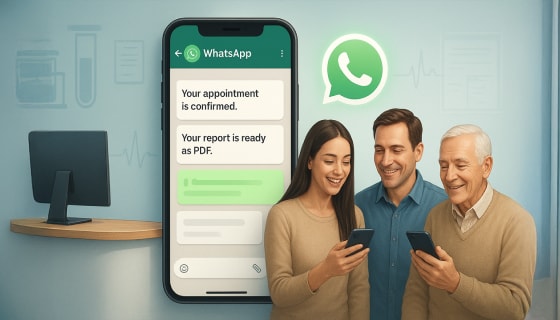As doctors, you’re meticulous about tracking your patients’ health — from blood pressure to test results, every detail matters in delivering the best care. But when it comes to tracking your practice’s health, why settle for guesswork? Every decision, from appointment scheduling to patient retention, has a direct impact on your growth. Yet, many practices still rely on intuition rather than actionable data to guide their decisions. And therein lies the problem. Without precise insights into your practice’s performance, you’re essentially flying blind. To truly grow, you need to measure what matters — patient flow, online engagement, and retention — so you can make smarter, more informed choices.
This isn’t just about keeping up with trends; it’s about using real data to shape the future of your practice. By tracking and analyzing the right practice data, healthcare practitioners can make informed, data-driven decisions that optimize operations, foster stronger patient relationships, and drive business growth. As we move into 2025, leveraging data-driven insights isn’t just a trend—it’s essential for smart growth and sustained success.
What Kind of Data Matters for Healthcare Practices?
For healthcare practices, the correct data is crucial in driving growth and optimizing operations. From Google reviews across multiple locations to patient appointment trends and inquiry sources, understanding where your practice is excelling and where improvements are needed can make all the difference. Tracking data, such as patient flow, no-show rates, and retention metrics, enables you to make informed decisions, enhance patient experiences, and ultimately build a stronger, more efficient practice. By focusing on the right metrics, you can unlock the insights needed for sustained success. The following are the key types of data that matter most for healthcare practices, and how they can drive smarter decisions…
Website Traffic: The Key to Unlocking Patient Engagement
Tracking website traffic provides crucial insights into how patients find your practice, whether through search engines, social media, or referrals. Let’s understand this better with a real case study. MultiCare Health System, a large healthcare provider, enhanced its online presence by focusing on local search engine optimization (SEO). By optimizing their Google My Business profile and refining their SEO strategy, they saw a 31% increase in website bookings. This enabled them to attract more targeted patients and increase their practice’s visibility to those seeking care. With this data, you can ensure your website is optimized to convert online visitors into real-life patients.
Appointment Bookings: The Direct Measure of Demand
Appointment bookings reflect the demand for your services and help you understand patient preferences. Let’s understand this with an example here of, Johns Hopkins Community Physicians, which implemented an automated self-scheduling system that allowed patients to book their appointments online. This innovation not only made the process more convenient for patients but also improved operational efficiency by reducing no-show rates and ensuring better resource utilization. As a result, the practice saw an increase in patient satisfaction and a smoother workflow.
By tracking appointment data, you can identify the peak times when patients prefer to book, optimize your staffing accordingly, and adjust your scheduling to meet demand more effectively. This ensures that you’re not only filling more slots but also providing a more personalized and efficient experience for your patients.
Inquiry Sources: Understanding Patient Journey
Understanding where your patients are coming from is key. For example, the Cleveland Clinic, a renowned healthcare institution, tracked its inquiry sources and found that organic search was driving a large portion of patient interest. By fine-tuning their SEO strategy, they experienced a significant surge in patient inquiries, accompanied by a corresponding increase in conversion rates. Knowing whether your patients are finding you through Google or social media helps you allocate your marketing resources to the most effective channels.
No-Show Rates: Minimizing Missed Opportunities
High no-show rates can disrupt your practice’s daily schedule and hurt revenue. A great example is Steward Health Care, which implemented Smart Scheduling to predict no-shows with 95% accuracy. By analyzing this data, they were able to send reminders and adjust their scheduling practices, which resulted in fewer missed appointments. Tracking no-show trends empowers you to minimize gaps in your schedule and optimize patient flow.
Patient Retention Metrics: The True Measure of Success
Patient retention is a vital metric for long-term practice success. HSG Advisors helped a healthcare system increase patient retention by 6-9%, resulting in an additional $25 million in revenue. They used retention data to improve patient satisfaction and loyalty. By tracking this data, you can pinpoint areas for improvement in the patient experience, leading to better retention, increased referrals, and long-term growth for your practice.
Essential Metrics Every Clinic Should Track — No Data Science Required
Tracking clinic performance metrics is crucial for practice growth, and it doesn’t require a data scientist to make sense of it. Simple metrics, such as appointment bookings, patient satisfaction, no-show rates, and website traffic, provide valuable insights into how your practice is performing. For example, analyzing appointment trends across multiple locations can help you identify busy times and adjust your schedule to avoid overbooking.
Monitoring patient satisfaction through reviews and feedback enables you to understand what is working and where improvements are needed. Likewise, keeping an eye on website traffic allows you to track how effectively your Google reviews are driving new patients, ensuring that your online presence is as strong as your in-clinic services. With these insights, you can make data-backed decisions that improve efficiency, patient loyalty, and ultimately, your bottom line.
Next, let’s uncover the top 5 key performance indicators that will guide your clinic toward more thoughtful decision-making and growth.
- Cost to Attract a New Patient: By monitoring this key performance indicator (KPI), you can determine the effectiveness of your marketing campaigns and referral programs. A lower cost indicates that your marketing strategies are working well, whereas a high cost may suggest inefficiencies in your approach to attracting new patients.
- Patient Retention Rate: The percentage of patients who continue to return for follow-up care or new visits. This KPI reflects patient satisfaction and loyalty. Tracking retention helps you identify how well you’re maintaining patient relationships and ensuring they feel valued. A high retention rate typically leads to a more stable patient base and greater referrals.
- Revenue per visit: It measures the income your clinic generates per patient appointment. This metric helps you evaluate the profitability of each service you offer, providing insights into which services are more lucrative. Optimizing service offerings based on this data can boost your clinic’s financial health.
- No-show rates: This indicates the frequency at which patients fail to attend their scheduled appointments. High no-show rates disrupt clinic operations and result in lost revenue. By tracking this KPI, you can implement reminder systems, flexible scheduling, and other strategies to reduce missed appointments, ensuring better resource utilization and patient care.
- Patient satisfaction score: It is one of the most telling KPIs. It’s typically measured through post-visit surveys or online reviews. High satisfaction rates often translate into repeat visits, positive reviews, and patient referrals. By tracking this metric, you can pinpoint areas of care that need improvement and continually enhance the patient experience.
Where to Find the Right Data: Tools to Get You Started
Now that you’ve got a solid understanding of the key KPIs your clinic should be tracking, the next step is knowing where to find the data that drives those metrics. Finding the correct data to fuel your clinic’s growth doesn’t have to be overwhelming. With the right tools, you can unlock actionable insights that enable you to make smarter decisions. Whether you’re tracking website traffic, managing patient engagement, or enhancing online visibility, there are powerful and user-friendly tools available that simplify the process. Let’s dive into some of the best platforms you can use to start tracking and analyzing key metrics for your practice’s success.
Google Analytics Basics
Google Analytics is a crucial tool for understanding how patients interact with your website. Whether it’s tracking how many visitors are landing on your site, where they’re coming from, or which pages they’re engaging with, Google Analytics gives you a wealth of data. By using this tool, you can analyze your website traffic, refine your SEO strategies, and tailor your content to better meet patient needs better. With its user-friendly interface, even beginners can easily track key metrics, such as bounce rates, page views, and conversion rates, ultimately helping you fine-tune your website to attract and retain more patients.
Google Business Profile Insights
A well-maintained Google Business Profile (formerly known as Google My Business) is crucial for any clinic aiming to boost its local visibility. This tool provides insights into how potential patients discover your clinic, the actions they take (such as making calls, visiting, or clicking on your website), and even how they engage with your reviews. With these data points, you can optimize your local SEO and enhance your profile to increase your clinic’s discoverability in Google searches and on Google Maps. Tracking these insights helps you attract new patients and improve your online reputation.
Facebook Ad Manager Simplified View
Facebook Ad Manager is a powerful platform for tracking the performance of your paid social media campaigns. Whether you’re running ads to promote services or special offers, Facebook Ads Manager allows you to see detailed data about how your ads are performing. From impressions to click-through rates (CTR) and conversion rates, this tool helps you understand how well your ads are resonating with your audience. With a simplified view, you can easily track which ads are driving engagement and use that information to improve future campaigns.
WhatsApp/CRM Manual Tracking
For clinics that want to maintain a more personal approach to patient communication, WhatsApp and CRM (Customer Relationship Management) systems can be handy. Tracking patient interactions manually through WhatsApp messages can give you direct insights into patient inquiries, feedback, and scheduling preferences. CRM software can further help by organizing patient data, appointment history, and follow-up reminders. With these tools, you can manually track patient engagement, improve customer service, and make your clinic more responsive and patient-friendly.
Dashboards and Reporting Made Simple
Now that you have the tools to collect the correct data, it’s time to focus on how to make sense of it. Dashboards and reporting enable you to visualize and interpret data in a way that facilitates more intelligent, faster decision-making. Instead of sifting through complex numbers, a good dashboard gives you a clear snapshot of your clinic’s performance at a glance.
These tools turn your raw data into actionable insights, empowering you to track key metrics and optimize your clinic’s growth. Let’s dive into some of the best tools that simplify this process and make reporting and data analysis easier than ever.
Free Tools for Tracking and Reporting
- Google Sheets: For a simple and free solution, Google Sheets offers everything you need to track and visualize your clinic’s data. You can create custom dashboards with pivot tables, charts, and data validation to track appointments, patient satisfaction, and Google reviews across multiple locations. It’s flexible, easy to use, and entirely accessible for beginners who want to get started with manual tracking without needing complex software.
- HubSpot Free CRM: It is a powerful tool that helps you manage and track patient data seamlessly. It enables you to create custom dashboards that visualize key metrics, such as patient retention, inquiries, and appointment follow-ups. By utilizing HubSpot’s user-friendly reporting features, you can monitor patient engagement with your clinic, segment your data, and make informed, data-driven decisions without the need for complex analytics.
- Zoho CRM Basics: If you need a simple CRM solution for tracking appointments and patient interactions, Zoho CRM offers a great starting point. It allows you to manage patient data, track appointments, and monitor marketing performance through basic reports. With Zoho, you can customize your dashboards to see patient engagement, conversion rates, and service performance all in one place.
Sample Visual Dashboard Ideas
Creating a visual dashboard can make your data not only easier to understand but also actionable. Here are a few sample visual dashboard ideas you can create with the tools mentioned above:
- Appointment Tracker: A bar chart or line graph to track daily, weekly, or monthly appointments. You can analyze trends, identify peak times, and adjust your staffing accordingly. This helps you optimize your schedule and reduce wait times, ensuring that you’re meeting demand efficiently.
- Google Reviews Tracker: A dashboard that tracks the number of Google reviews for each location can help you maintain a strong online reputation. You can monitor ratings, sentiment, and even spot trends in patient feedback. This is an excellent way to ensure you’re responding to feedback and improving your patient experience.
- Revenue by Service Dashboard: A pie chart or bar graph to visualize revenue per service or location. This helps you understand which services are the most profitable and can guide decisions on pricing, resource allocation, and which services to expand or improve.
- Patient Retention and Referral Dashboard: A line chart or bar chart showing patient retention and referrals over time. By tracking these metrics, you can determine whether patients are returning for follow-up appointments and how many new patients are being referred. This helps you understand patient loyalty and optimize your referral programs.
How to Use Data to Make Better Decisions
Now that you’ve set up the right tools and dashboards to track your clinic’s key data, it’s time to put that data to work. The actual value lies in using insights to make smarter decisions that drive growth and improve patient experiences. Here’s how you can leverage your clinic’s data to make strategic decisions and optimize your operations.
Allocate Ad Budgets Smarter
When it comes to advertising, one of the most effective ways to utilize your data is by understanding where your marketing dollars are being spent and what yields the best results. By analyzing patient inquiries, conversion rates, and click-through rates (CTR) across various platforms, such as Google Ads or Facebook Ads, you can identify which campaigns are generating the most qualified leads. For instance, if your Google review campaigns are generating more inquiries than your paid ads, it may be time to allocate more budget to those campaigns. Data lets you stop wasting money on ineffective ads and instead invest in what truly drives results, ensuring a higher return on investment (ROI).
Improve Website and Booking Experience
Your website often gives potential patients the first impression of your clinic. If you’re tracking website traffic and conversion rates, you can see if your website is turning visitors into appointments. If you notice that a high percentage of users are leaving after visiting the booking page, this could signal that the booking experience is too complex or frustrating. By analyzing this data, you can make informed decisions to simplify your booking process, streamline the user experience, and eliminate any obstacles that prevent visitors from becoming patients. Improving the patient journey online translates to more bookings and happier, loyal patients who appreciate the convenience of your services.
Focus on What’s Working — Drop What’s Not
Data isn’t just about tracking everything—it’s about focusing on what drives success. If you’ve been tracking Google reviews, you’ll quickly spot which locations or services are receiving the most praise and which ones may need a little extra attention. Perhaps one clinic location has higher review ratings than another, suggesting that certain practices, staff members, or services are particularly resonating with patients. By analyzing this, you can replicate success across other locations and adjust strategies where necessary. Similarly, if specific marketing channels aren’t converting, it might be time to pivot your strategy, focusing on the platforms that are performing better and dropping ineffective efforts. Ultimately, data enables the continuous improvement of operations by directing resources where they have the most significant impact.
Understanding Healthcare Data: A Tabular Breakdown of Key Metrics and Their Impact
| Types Of Healthcare Data | Impact on Practice Growth and Patient Care | Why It Matters | Actionable Strategies for Data Utilization |
| Patient Demographics | Enables personalized care and builds patient loyalty. | Helps tailor treatments based on patient characteristics. | Segment by age, gender, and conditions to create customized care plans. |
| Patient Feedback and Satisfaction | Improves retention, loyalty, and boosts referrals. | Addressing feedback leads to better patient experiences and trust. | Collect feedback via surveys and reviews, respond to concerns, and adjust services accordingly. |
| Appointment Scheduling Data | Enhances efficiency, reduces wait times, and prevents overbooking. | Optimizes scheduling to meet patient demand effectively. | Use scheduling software to manage peak times and implement reminders to reduce no-shows. |
| Financial Data | Maximizes revenue and improves financial planning. | Helps manage expenses and track practice profitability. | Analyze revenue per visit, adjust pricing strategies, and identify areas for cost reduction. |
| Clinical Data (Test Results, etc.) | Improves diagnosis accuracy and treatment effectiveness. | Supports better decision-making, leading to improved patient outcomes. | Track patient outcomes and adjust treatments using clinical decision support systems to inform treatment decisions. |
| Operational Data (Staff Performance) | Optimizes staff efficiency and improves patient flow. | Enhances workflow and reduces inefficiencies. | Use performance metrics to improve staffing schedules and resource allocation. |
Common Mistakes to Avoid in Healthcare Analytics
In the pursuit of better data analysis and making more informed decisions, it’s easy to fall into the trap of focusing on numbers that don’t drive meaningful results. Healthcare analytics can be compelling only if you’re measuring the right things. Let’s look at some common mistakes to avoid in healthcare analytics to ensure you’re using data effectively to grow your clinic.
Tracking Vanity Metrics
Focusing on metrics like website visits or social media likes without considering their impact on patient bookings or retention wastes time. Track metrics directly impacting your clinic’s success, such as appointment conversions and revenue per visit.
Not Tracking Where Leads Come From
Not understanding where your patients are coming from is a major pitfall. If you’re not tracking attribution, you might invest in channels that aren’t driving results. Understand which sources bring in patients, whether it’s organic search, paid ads, or referrals, so that you can optimize your budget.
Overcomplicating Data Analysis
Complex data without focus leads to confusion. Keep things simple and focus on the most impactful metrics. Track the data that matters most to your clinic’s growth, such as patient satisfaction, appointments, and conversion rates.
Failing to Monitor Data in Real-Time
Waiting for weekly or monthly reports can delay your response time. Monitor real-time data to make immediate adjustments. For example, if no-show rates spike, you can quickly implement strategies, such as appointment reminders, to resolve the issue.
Monthly Tracking Checklist for Medical Practices
Now that you understand how to use data to make smarter decisions and avoid common mistakes in healthcare analytics, the next step is ensuring you stay on track with consistent monitoring. With a 10-minute monthly review habit, you can quickly assess your clinic’s performance and adjust before minor issues become bigger challenges. The key is consistency.
Setting aside just 10 minutes each month allows you to review critical data, spot trends, and make data-driven decisions without feeling overwhelmed. This habit not only helps you track clinic performance, but also ensures you’re making continuous improvements.
Let’s discuss the key areas to focus on during your quick monthly review.
10-Minute Monthly Review Checklist
- Review Appointment Bookings & No-Show Rates
- Check how many appointments were scheduled vs. how many were missed.
- Look for patterns in no-show rates and see if reminders or changes to scheduling could help reduce them.
Actionable Insight: Consider adjusting appointment reminders or optimizing booking slots to avoid overbooking during peak times.
- Patient Satisfaction & Google Reviews
- Review your Google reviews and patient feedback to identify recurring themes or improvement areas.
- Check if the average ratings are increasing or decreasing.
Actionable Insight: If reviews are generally positive, identify which services drive the highest satisfaction. If negative reviews are appearing, address the specific issues promptly.
- Website Traffic and Conversion Rate
- Take a quick look at your website traffic using tools like Google Analytics.
- Identify which pages receive the most visits and which lead to conversions, such as appointment bookings or contact form submissions.
Actionable Insight: Focus on improving pages with high traffic but low conversions. Consider adding clear calls to action or improving user experience to increase conversions.
- Revenue per Visit
- Review your revenue per visit to identify whether certain services or locations outperform others.
- Verify if any services are underperforming or identify opportunities to increase revenue.
Actionable Insight: If certain services are more profitable, consider promoting them more or adjusting pricing strategies for other services.
- Patient Retention & Referrals
- Examine the ratio of returning patients to new patients. Are patients referring others to your clinic?
- Track your referral sources to understand where your patients are coming from and which channels drive new patient acquisition.
Actionable Insight: Focus on strategies encouraging patient retention and referrals, such as offering loyalty programs or referral incentives.
Bonus Tip: Set Reminders for Key Metrics
To make this 10-minute habit more effective, set monthly reminders for each metric you need to track. This will keep your review consistent and ensure you don’t miss important data. Over time, these 10-minute reviews will become a natural part of your routine, enabling you to make more informed decisions without dedicating hours to data analysis.














